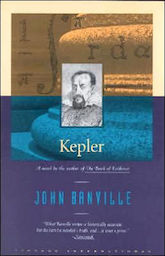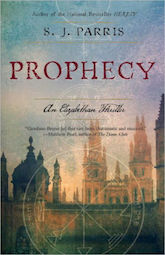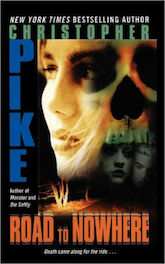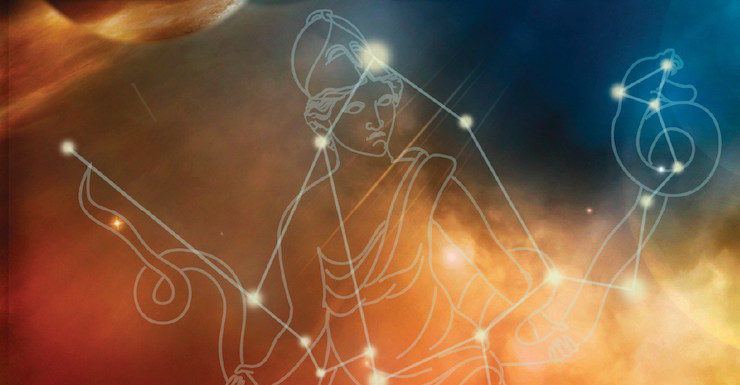Astrology is on the rise among millennials and post-millennials, arguably strange considering within the last two hundred years science has become an almost universally accepted paradigm. Perhaps this new interest constitutes a counter-reaction to the sway of science-as-truth, or maybe it’s a symptom of our uncertain times. It might be the profoundly human desire to know when we might fall in love or strike it rich (after all, who wouldn’t?), but there is no arguing that astrology and its accompanying paraphernalia (tarot decks and apps, sacred grids, crystals) hold a major appeal for this generation.
In my novel Wonderblood, I use astrology as a tool for examining faith, specifically, what it means to have faith in a dire prediction. But just as much as I love the threat of a good apocalypse, I love reading and writing about the tools astrologers use to make their predictions. Perhaps astrology is so appealing because it can seem an awful lot like science, with its charts, angles, degrees and timelines. To that end, I’ve found that several of these books are set in the 16th century, a fascinating historical moment when science and religion overlapped. As a voracious reader of multiple genres, I wanted to include a little something for everyone here—everyone who likes astrology, that is. So here are five stories that feature the “music of the spheres.”
Kepler by John Banville
 In this second installment of Banville’s (underrated) Revolutions Trilogy, Johannes Kepler, the famed astronomer who discovered the scientific laws governing planetary motion, unhappily whiles away his time concocting horoscopes for the eccentric and probably insane Holy Roman Emperor Rudolf II. Despite Kepler’s frustration at having to cater to Rudolf’s manic astrological whims, he is firmly a man of his times: at the turn of the 16th century, most people believed the configurations of the heavens truly affected human destiny. However, Banville takes pains to demonstrate that Kepler is endlessly tormented by his desire to reconcile astrology with the increasingly complex mathematics required to prove his scientific laws. Kepler may have proven the elliptical orbits of the planets, but he also drew up over 800 horoscopes, speculated on the outcomes of wars and weather events, declared a supernova in 1604 to herald the conversion of America, and correctly predicted the month of a patron’s death. Banville’s writing style is excellently suited to describing Kepler’s apparently dour personality: some turns of phrase are so surprising and gross and gorgeous that they have never left me.
In this second installment of Banville’s (underrated) Revolutions Trilogy, Johannes Kepler, the famed astronomer who discovered the scientific laws governing planetary motion, unhappily whiles away his time concocting horoscopes for the eccentric and probably insane Holy Roman Emperor Rudolf II. Despite Kepler’s frustration at having to cater to Rudolf’s manic astrological whims, he is firmly a man of his times: at the turn of the 16th century, most people believed the configurations of the heavens truly affected human destiny. However, Banville takes pains to demonstrate that Kepler is endlessly tormented by his desire to reconcile astrology with the increasingly complex mathematics required to prove his scientific laws. Kepler may have proven the elliptical orbits of the planets, but he also drew up over 800 horoscopes, speculated on the outcomes of wars and weather events, declared a supernova in 1604 to herald the conversion of America, and correctly predicted the month of a patron’s death. Banville’s writing style is excellently suited to describing Kepler’s apparently dour personality: some turns of phrase are so surprising and gross and gorgeous that they have never left me.
Zodiac by Romina Russell
 Speaking of astrological accoutrements, Romina Russell’s young protagonist in this first novel of her Zodiac series needs none—Rhoma Grace, called Rho, uses only her intuition to make her predictions. This talent causes her confusion and uncertainty, but also catapults her into a unique position: when a disaster strikes a moon orbiting House Cancer, her home, and kills many, Rho is unexpectedly named the House’s new Guardian. This novel entertains the premise that there were once 13 Houses in Zodiac Galaxy. As more Houses are ravaged by catastrophic weather, Rho begins to believe that the exiled Guardian of the 13th House has returned to wreak havoc on the remaining 12 Houses. Original and astonishingly well-imagined, this novel is a futuristic spin on an ancient idea, giving literal life (in space!) to a timeless mythological concept.
Speaking of astrological accoutrements, Romina Russell’s young protagonist in this first novel of her Zodiac series needs none—Rhoma Grace, called Rho, uses only her intuition to make her predictions. This talent causes her confusion and uncertainty, but also catapults her into a unique position: when a disaster strikes a moon orbiting House Cancer, her home, and kills many, Rho is unexpectedly named the House’s new Guardian. This novel entertains the premise that there were once 13 Houses in Zodiac Galaxy. As more Houses are ravaged by catastrophic weather, Rho begins to believe that the exiled Guardian of the 13th House has returned to wreak havoc on the remaining 12 Houses. Original and astonishingly well-imagined, this novel is a futuristic spin on an ancient idea, giving literal life (in space!) to a timeless mythological concept.
The Luminaries by Eleanor Catton
 This much-vaunted and ambitious novel opens with its characters (who correspond to the signs of the zodiac) described in an astrologically inspired chart listing their houses and related influences—and charts are a bit like candy if you’re a reader into astrology. While ostensibly a murder mystery in the style of the 19th century writer Wilkie Collins, The Luminaries simultaneously employs astrology as a framework for the novel’s events, with Catton choosing even the date of the novel’s opening scene because of its astrological significance: three planets converge in Sagittarius on 27 January 1866. From there, Catton beautifully and somewhat mysteriously tracks the movements of her characters as though they were heavenly bodies—they rise and set, in some cases disappearing from the text completely. This book is many things: fascinating historical fiction about New Zealand’s gold rush, a well-crafted murder mystery, and not least a grand and detailed meditation on the stars’ influence on earthly events.
This much-vaunted and ambitious novel opens with its characters (who correspond to the signs of the zodiac) described in an astrologically inspired chart listing their houses and related influences—and charts are a bit like candy if you’re a reader into astrology. While ostensibly a murder mystery in the style of the 19th century writer Wilkie Collins, The Luminaries simultaneously employs astrology as a framework for the novel’s events, with Catton choosing even the date of the novel’s opening scene because of its astrological significance: three planets converge in Sagittarius on 27 January 1866. From there, Catton beautifully and somewhat mysteriously tracks the movements of her characters as though they were heavenly bodies—they rise and set, in some cases disappearing from the text completely. This book is many things: fascinating historical fiction about New Zealand’s gold rush, a well-crafted murder mystery, and not least a grand and detailed meditation on the stars’ influence on earthly events.
Prophecy by S.J. Parris
 Another entry set in the early 16th century, Prophecy by S.J. Parris (the pen name of journalist Stephanie Merritt) concerns dire predictions, Queen Elizabeth’s personal astrologer and famous occult philosopher John Dee, and murder most foul. Dee remarks in the opening pages “…This transition into the sign of Aries at the end of our troubled century has been prophesied by many as signifying the end of history.” The protagonist here is none other than Giordano Bruno himself, an excommunicated friar who believed, among other things, in the infinity of the universe and that stars are “other suns with their own planets.” As the investigative hero in this historical thriller, Bruno sets out in the year of the Great Conjunction to discover if black magic has indeed killed one of Elizabeth’s handmaids. Replete with historical detail, smokey superstition and its accompanying magical intrigue, this is the second book in a series with Bruno playing detective.
Another entry set in the early 16th century, Prophecy by S.J. Parris (the pen name of journalist Stephanie Merritt) concerns dire predictions, Queen Elizabeth’s personal astrologer and famous occult philosopher John Dee, and murder most foul. Dee remarks in the opening pages “…This transition into the sign of Aries at the end of our troubled century has been prophesied by many as signifying the end of history.” The protagonist here is none other than Giordano Bruno himself, an excommunicated friar who believed, among other things, in the infinity of the universe and that stars are “other suns with their own planets.” As the investigative hero in this historical thriller, Bruno sets out in the year of the Great Conjunction to discover if black magic has indeed killed one of Elizabeth’s handmaids. Replete with historical detail, smokey superstition and its accompanying magical intrigue, this is the second book in a series with Bruno playing detective.
Road to Nowhere by Christopher Pike
 For an author who has nearly covered the gamut of metaphysical and supernatural topics, Christopher Pike has written surprisingly little about astrology, but a mysterious fortune teller features in this book—admittedly one of Pike’s minor works, but a fun read nonetheless. Eighteen-year-old Teresa’s boyfriend leaves her for her best friend, so she takes her car and heads north with no destination in mind. Along the way, she picks up a couple of chatty hitchhikers who call themselves Freedom Jack and Poppy Corn. The story-within-a-story is a classic Pike trope, and Road to Nowhere finds his car-bound characters regaling Teresa with alternating parts of the same tragic story, one that becomes more horrific as their journey continues. After a stopover at a castle to visit Jack’s “mother” (a fortune-teller who uses an unconventional astrology), Teresa begins to think her passengers are not who they appear to be. Originally published in the early ’90s and reissued in 2011, Road to Nowhere is vintage Pike—dark, scary, paranormal and, in the end, oddly luminous. I hope a new generation of YA readers discover the magic of this author.
For an author who has nearly covered the gamut of metaphysical and supernatural topics, Christopher Pike has written surprisingly little about astrology, but a mysterious fortune teller features in this book—admittedly one of Pike’s minor works, but a fun read nonetheless. Eighteen-year-old Teresa’s boyfriend leaves her for her best friend, so she takes her car and heads north with no destination in mind. Along the way, she picks up a couple of chatty hitchhikers who call themselves Freedom Jack and Poppy Corn. The story-within-a-story is a classic Pike trope, and Road to Nowhere finds his car-bound characters regaling Teresa with alternating parts of the same tragic story, one that becomes more horrific as their journey continues. After a stopover at a castle to visit Jack’s “mother” (a fortune-teller who uses an unconventional astrology), Teresa begins to think her passengers are not who they appear to be. Originally published in the early ’90s and reissued in 2011, Road to Nowhere is vintage Pike—dark, scary, paranormal and, in the end, oddly luminous. I hope a new generation of YA readers discover the magic of this author.
 Julia Whicker is a graduate of the Iowa Writers’ Workshop. She’s had her poetry and essays published in the Iowa Review, Word Riot and The Millions, among others, and has been nominated for a Pushcart Prize. Her first novel Wonderblood is now available from St. Martin’s Press. She lives with her husband and daughter in Pennsylvania.
Julia Whicker is a graduate of the Iowa Writers’ Workshop. She’s had her poetry and essays published in the Iowa Review, Word Riot and The Millions, among others, and has been nominated for a Pushcart Prize. Her first novel Wonderblood is now available from St. Martin’s Press. She lives with her husband and daughter in Pennsylvania.











Worryingly it is not just belief in astrology that is on the rise in millennials, but also the number of millennials who believe in Flat Earth Bollocks Theory is on the rise too. That is truly scary.
https://www.indy100.com/article/flat-earth-millennials-believe-study-yougov-conspiracy-theory-young-people-religion-politics-income-8285961
Neal Stephenson’s Quicksilver comes to mind.
@1, What does Astrology have to do with Flat-Earthers, exactly? Astrology is connected to the obscure and the esoteric, disciplines that humans have failed to grasp in their entirety. Flat-Earthers negate Science heavily and create an alternative reality that isn’t supported by facts. Even though I am skeptic (and many others, surely) about the first one, there’s nothing to be skeptic about Flat-Earthers: they’re wrong.
Melissa Scott’s Astreiant series does interesting things with astrology, not only in the presence and importance of it in everyday lives, but because the secondary-world setting has an entirely different set of heavenly bodies to keep track of.
Very cool, thanks! I’m reading The Queens of Innis Lear and have enjoyed the astrology/astrolatry in that. I’ll be sure to check out some of these others.
check out Melissa Scott, five twelfth’s of heaven, and it’s two sequels. It probably isn’t that close to identifiable astrolog, but the magi and ships go with the symbolic logic of astrology… a rather interesting version of the any sufficiently advanced tech is indistinguishable from magic idea.
Anyone remember John Crowley’s Aegypt cycle??
@2 Surely Neal Stephenson’s Zodiac would be more appropriate? ;)
(Not really because it’s named after the type of boat called a Zodiac, and the lead character is a scientist).
Fun fact, the way we hand out zodiacal signs is two thousand years out of date, and thus, wrong. Originally your zodiac sign was down to which constellation the sun was in when you were born. However, over time this has shifted almost an entire month. So if you were born on (eg) the 1st of January, you’d be called a Sagittarius, however, on the 1st of January the sun is actually in Capricorn.